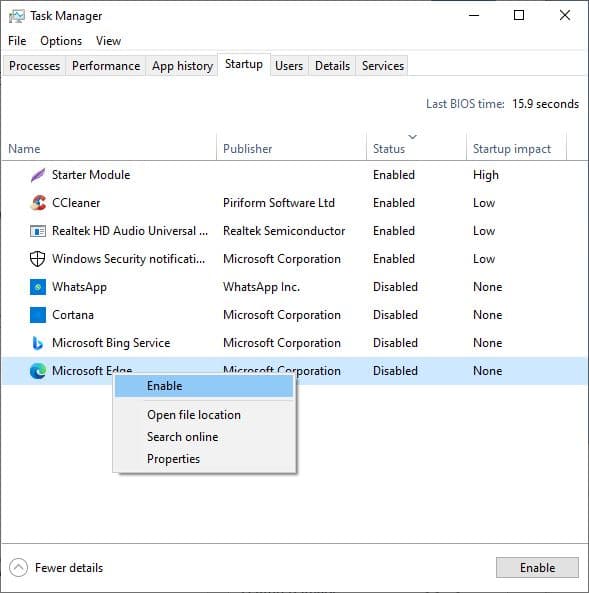Adding programs or apps to the startup process is simple and convenient. If you want your favorite apps to start up automatically with your Windows 11 PC, It can be done by adding the app or programs to the startup folder on your Windows computer. This article explains how to add a program or application to startup in Windows 10.
How to Add Apps to Your Startup on Windows
Whether it’s your go-to email client, a frequently used productivity tool, or a specific Microsoft Excel or Word file, setting them up for startup can save you time and streamline your workflow. Here are easy methods to add your preferred application to startup Windows 11.
Using Task Manager
The Task Manager in Windows is essential for monitoring running applications and processes, providing valuable CPU, Memory, Disk, and Network usage information. It also lets you manage startup apps, ensuring quick access to essential programs upon system boot-up.
- Right-click on the Start button and select “Task Manager” from the menu.
- In Task Manager, go to the “Startup” tab, right-click on the desired program, and choose “Enable” from the contextual menu.
- The app will now be added to the startup list, and it will automatically launch each time you start your computer.

Add the app to stratup folder
Another straightforward method to add application to startup windows 10 computer is by using the Startup Folder. This method involves manually placing the app or program icon in the designated Startup Folder, which ensures it launches automatically during system startup.
- Right-click on the Start button and choose “Run” from the menu.
- In the Run Command window, type “shell:startup” and click “OK” to open the Startup Folder.
- Open Run Command again and type “shell:appsfolder” to open the modern Apps folder.
- Find the app you want to add to startup in the Apps folder and drag it into the Startup Folder.
The app will now launch automatically upon computer startup.
Add Excel or Word Files to Startup
If you are looking for add Microsoft excel or word file to startup, you can do this by adding file shortcut to startup folder on your computer.
- Right-click on the Excel or Word file and select “Create Shortcut” from the menu.
- Open Run Command, type “shell:startup,” and click “OK” to open the Startup Folder.
- Drag the shortcut you created into the Startup Folder.
Your Excel or Word file will now be part of the startup process.
Tweak Registry Editor
Also you can tweak windows Registry Editor to quickly add application to startup in windows 11.
- First Right-click on the shortcut icon of the app you wish to add to startup and select “Properties.”
- In the Shortcut tab, copy the location mentioned next to the “Target” option.
- Now Press “Windows + R” Type regedit and hit Enter to open the Registry Editor.
- Nevigate to the following location: HKEY_LOCAL_MACHINE\Software\Microsoft\Windows\CurrentVersion\Run
- Right click on Run -> New -> String Value and the app you want to add to startup.
For example, if you want to add “VLC Media” to startup, name the String Value “VLC”
- Double-click on the newly created String Value and paste the Target location you copied earlier into the “Value data” section.
- Click “OK” to save the changes in the Registry Editor.
The app will now automatically launch each time you start your computer, ensuring quick accessibility and convenience.
Also read:
- WIFI says connected But no internet Access on Windows 10 laptop (Solved)
- Dell Laptop Black Screen Problem on Windows 11 [Solved)
- Computer crashes when playing Games windows 11 (Solved)
- Solved: GeForce Game Ready Driver Installation Can’t continue
- How to Remove Watermark From Photo Online free in 2023
- Solved: Bluetooth disappeared or not working on Windows 11